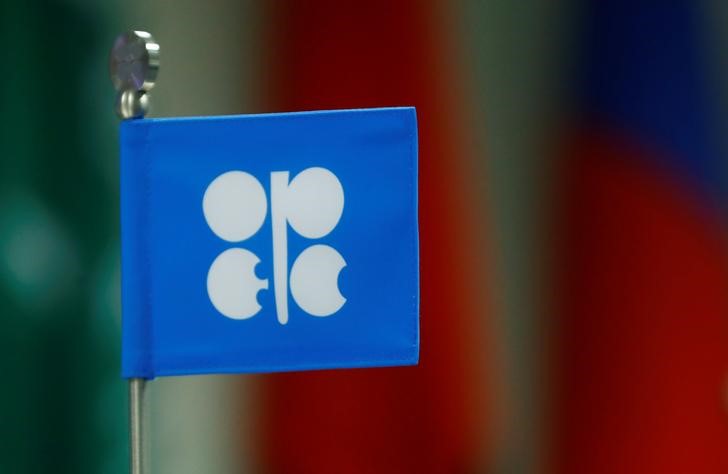 © Reuters. A flag with the Organization of the Petroleum Exporting Countries (OPEC) logo is seen during a meeting of OPEC and non-OPEC countries in Vienna
© Reuters. A flag with the Organization of the Petroleum Exporting Countries (OPEC) logo is seen during a meeting of OPEC and non-OPEC countries in ViennaBy Henning Gloystein and Keith Wallis
SINGAPORE (Reuters) – Asian refiners are losing no time reacting to a decision by OPEC and Russia to extend their agreed production cuts to all of 2018, ordering more oil from the Caribbean and Gulf of Mexico in a move that will result in lost OPEC and Russian market share.
Output cuts aimed at tightening the market to prop up prices have been in place since January and were to expire in March 2018, but the Organization of the Petroleum Exporting Countries (OPEC), together with non-OPEC producers including Russia, extended those cuts on Thursday, to cover all of 2018.
Despite this, oil supplies remain ample. Even before the official announcement on Thursday to extend the cuts, refiners in Asia, the world’s biggest consumer region, had already put in enquiries for oil shipments from the Gulf of Mexico and the wider Caribbean, particularly from the United States, Mexico, Venezuela and Colombia, tanker operators said.
“There have been many enquiries from Asia for oil tanker shipments from the Gulf of Mexico and Caribbean. Now that we know OPEC’s cuts will be extended, these enquiries are being turned into orders,” said a broker who specializes in long-haul crude oil shipments, declining to be named as he was not authorized to talk to media about ongoing negotiations.
‘CHRISTMAS COMES EARLY’
OPEC’s and Russia’s biggest problem with cutting output has been that it has led to higher U.S. production and market share.
In a note to clients titled “Christmas comes early,” Barclays (LON:) bank said on Friday: ” oil exports to China could easily double next year as U.S. production and export capacity expands … (and) OPEC countries will see their market shares in Asia decline further.”
Shipping data in Thomson Reuters Eikon shows oil shipments from the Gulf of Mexico and the Caribbean to Asia’s consumer hubs of China, Japan, South Korea, Taiwan and Singapore have already soared from around half a million barrels per day (bpd) in January, when the OPEC-led cuts were implemented, to over 1.2 million bpd in November and December.
The biggest increase in exports to Asia have been coming from the United States, where output is soaring thanks to shale oil drillers.
U.S. oil production
“The real winners (of the cuts) will be the U.S. producers,” said Matt Stanley, a fuel broker for Freight Investor Services in Dubai.
Consultancy Rystad Energy expects U.S. output to reach 9.9 million bpd this year, bringing it close to levels of top producers Russia and Saudi Arabia.
Stronger North American oil supplies to Asia benefit shippers as this is one of the world’s longest trade routes, meaning chartered tankers spend more time at sea.
The U.S.-Asia route is at least twice as long as that from the Middle East to the main Asian trading hubs in China, Japan, South Korea, Taiwan and Singapore.
“We believe the ‘new trades’ (from North America to Asia) will develop further, which is long-term positive for shipping,” said Robert Hvide Macleod, chief executive of Frontline Management, a major tanker owner.
The ripple effects of ongoing OPEC cuts will also affect refinery output. U.S. crude oil tends to be relatively light and sweet in quality, as opposed to the heavier and sourer grades that many Middle East producers export.
Mike Petrut, a petroleum researcher at Industrial Info Resources Oceania in Perth, Australia, said an increase in supplies of light U.S. crude at the cost of heavy crudes from OPEC would mean higher gasoline output by Asian refiners, and a lower yield of heavier products like fuel oil.
Source: Investing.com


























